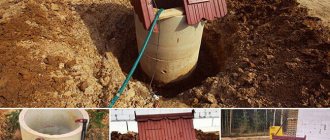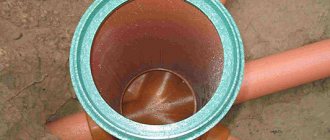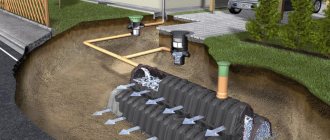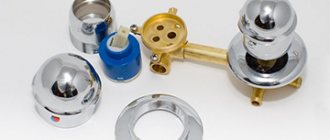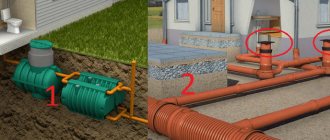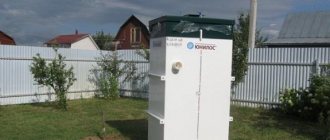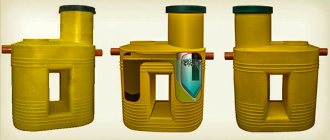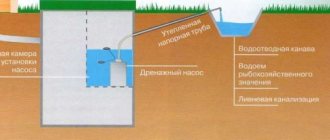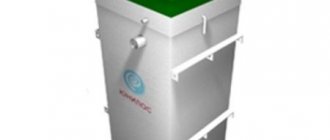As you probably know, “storm drainage” (that’s what storm drainage is often called) is preferable for arranging it in a variety of places: at a summer cottage, on road, construction and industrial sites, in parks and walking pedestrian areas... In fact, It is almost impossible to list everything. But at the same time, the purpose of the storm drain, wherever it is installed, is, in general, one: to ensure the effective and unhindered outflow of melt or rain water from the site. Indeed, in the case of ineffective storm drainage, or its complete absence, such certainly not very pleasant phenomena may arise, such as:
- flooding and even waterlogging of the site;
- the formation of puddles that will make it difficult to move around the site and carry out any work on it;
- washing away the foundations of those structures located on the site;
- the formation of corrosion, fungi and mold on the walls;
- deterioration of health due to prolonged stay in conditions of high humidity;
- contamination of the object.
Storm sewer can be of two types: point - the flow of water is collected in a certain place and linear - storm water is collected along a line.
Of course, storm drainage will help avoid all this. Moreover, it comes in only two types - point type and linear. In the first case, water collection is carried out in any one place. In the second, rain collectors are located along a line and connected to each other with a special wire. But one way or another, in the vast majority of cases, when organizing effective storm drainage, you will need a device such as a sand trap for storm drainage.
What else you need to remember when arranging a storm drain
In order for a storm drain to successfully cope with all its responsibilities for draining water flow, it is imperative to take into account some points. First, in order to prevent clogging and clogging of the system, it is necessary to provide inlet protective grilles. They can be made of different materials and come in a variety of shapes. But they have one purpose. Or rather, two. Firstly, the retention of coarse debris - branches, stones, leaves, etc. Secondly, the gratings will guarantee the safe passage of people and vehicles.
The photo shows sand traps, storm water inlets, gutters with gratings of various shapes and sizes.
Important! When designing a storm drainage system, it is necessary to ensure that the optimal slope of the watercourse is ensured.
The water will simply flow away, obeying the force of gravity. The angle of inclination must take into account the diameter of the pipe. The relevant standards are found in SNiPs for storm drainage. But in most cases, for a private, not too branched storm drain, it will be enough to provide a slope of 1-2 centimeters for each meter of pipe.
Before entering the sand trap for storm drainage, the slope should be reduced somewhat so that the flow does not mix inside the trap box, and the sand fractions have time to settle in it. Absolutely all sewerage elements must be sealed. Even the slightest leak is not allowed. This will prevent not only erosion of the soil and damage, for example, to the road surface, but also the formation of mold, rot, etc.
Pipes that are corrugated inside are highly not recommended for storm sewer installations. After all, it is often in them that debris accumulates. In the future, this will inevitably lead to the formation of a garbage plug, getting rid of which may not be a simple task, as it may seem at first glance.
When designing a storm drainage system, it is necessary to provide for as few possible joints, differences, and changes in direction as possible. After all, it is in these places that depressurization of the system most often occurs.
You should take your measurements especially carefully. Footage is a very important component of the project. Even in case of doubt, it is better to purchase pipes with an inlet. Modern plastic pipes can be cut to the required length very easily and quickly. But it will be very disappointing if in the end it turns out that literally 10-20 centimeters of pipe are missing. The same applies to purchasing all the necessary adapters, fittings, seals, etc. You need to make a detailed list of everything you need to purchase in advance.
When organizing inspection wells, it is recommended to install them more often. In this way, it will be possible to monitor the state of the entire system more efficiently. In general, the following rule works here: the smaller the diameter of the pipe, the smaller the distance between the wells should be. Indeed, in this case, the risk of a blockage also increases, and it will be a shame not to get to the area needed for cleaning just because the inspection well cannot reach there.
Description and principle of operation of sand traps
Sand traps are used to retain sand and other impurities from wastewater with a particle size of more than 0.15-0.25 mm at wastewater flow rates of more than 100 m3/day. The number of sand trap compartments is accepted to be at least two, both of which are working. Depending on the direction of the main flow of wastewater, sand traps are divided into vertical and horizontal, which, in turn, are divided into simple and aerated. The type of sand trap must be selected taking into account its throughput, wastewater composition and local construction conditions.
Horizontal sand traps with circular movement of wastewater are designed to remove sand from wastewater that has a neutral or slightly alkaline reaction. Wastewater is supplied to sand traps and removed from them by trays. To turn off the sand traps from operation, shutters are installed on the supply trays in the distribution chamber. Sediment from sand traps is removed by hydraulic elevators. The supply of working fluid to the hydraulic elevators and the removal of pulp are carried out by independent pressure pipelines, through a switching chamber equipped with valves.
Horizontal sand traps with linear movement of wastewater and a throughput capacity of 70-280 thousand m3/day are used at a number of sewer aeration stations. Sand traps work effectively when the average speeds are equalized along their length. This is achieved by using single flat gratings at the inlet device, made of wooden rods 15 cm wide with gaps of 6 cm. In sand traps with gratings of this design, the water load is increased by increasing the flow rate while maintaining the efficiency of sand retention.
Aerated sand traps are used to separate mineral particles contained in wastewater with a hydraulic particle size of 13–18 mm/s.
The supply of wastewater to the sand traps and its removal are carried out by open trays. The aeration system uses air from a pump-air station. The sediment is washed into the sand trap bunker by a hydromechanical system, including a longitudinal tray and pipelines with sprays; the sediment is removed from the bunker using a hydraulic elevator. Aerated sand traps are made in the form of horizontal tanks. Aerators are installed along one of the walls at a distance of 45-60 cm from the bottom along the entire length of the sand trap, and a trench for sand is installed under them. The cross section of the bottom is sloped
i = 0.2-0.4 to the central tray for gravity discharge of sand mass into it.
Vertical sand traps consist of a receiving and settling compartment and a sedimentary part. The sand trap can be round or rectangular in plan and should consist of two sections.
When the throughput of mechanical treatment facilities is more than 100 m3/day of wastewater, a vertical sand trap of a tangential type or a sand trap with a downward-ascending movement of liquid is used.
The operation of such sand traps is based on a qualitatively new principle. Wastewater enters the sand trap tangentially, resulting in its rotational movement. The sand contained in the wastewater is pressed against the walls due to centrifugal force and is separated from the water as a result of the resulting downward flow.
The removal of water from the sand trap by a central telescopic pipe further intensifies the separation of sand by creating a water funnel around the receiving hole of the pipe. Sand is washed from organic impurities during its removal in a screw sand washer.
Sand trap for storm drainage as an integral part of the system
Almost any storm drain requires the presence of the following elements:
Shown here is a detailed diagram of the storm drainage system with all its integral components.
- rainwater inlets. They, as you can guess from the name itself, are designed to absorb water. As a rule, the rainwater inlet is located either under the drainpipe or in the path of the flowing water flow;
- door trays - have the same functional purpose as storm water inlets, but are installed only in front of doors and gates. In this case, the owner of the property will not observe the accumulation of puddles in front of his door after every rain;
- gutters or pipes - they are a kind of drainage main through which flows from the storm inlet enter the collector or other designated container;
- A sand trap for storm drainage is a special device, thanks to which not only sand, but also particles of suspended soil comparable in size settle in the box and do not enter the drainage system.
Also, depending on the design features, storm sewerage may include the presence of all kinds of filter structures, wells, etc.
What does it consist of?
The design and dimensions of the sand trap largely depend on what impurities need to be removed . To work with bound sand (a mixture of solid organic matter and sand), long sand traps are used, or they are equipped with a washing mechanism.
The main elements of the equipment are:
- the main reservoir, consisting of two parts: a working one, through which the discharged water passes, and a sedimentary one for collecting sand, as well as two pipes - inlet and outlet;
- a mechanism for moving sediment towards the pit;
- a device for removing sand from a container.
The sand container is located in the head part under the working tank. Can also be located on top. The sand that falls to the bottom is moved into the bunker by scrapers or hydromechanically - by water, which is injected through pipes laid along the bottom.
For normal operation of the equipment, deposited sand should be removed in a timely manner . On small devices it is removed manually.
If more than 0.1 m3 of sediment accumulates per day, its mechanized removal must be ensured.
Depending on the design, sand is unloaded
- sand pumps,
- hydraulic elevators,
- augers,
- buckets.
At large treatment plants, precipitated sand from the bunker is transported to special sites where it is dewatered.
For this we use:
- hydrocyclones,
- screw centrifuges,
- hydraulic and mechanical sand washers,
after which the treated sand can be reused without risk to the environment.
Purpose of a storm drain sand trap
In principle, you can guess its purpose just by the name of this device. Indeed, a sand trap for storm sewers is designed to prevent not only sand from entering the drainage system, but also other fine debris that is not retained by the protective gratings of the storm drains. This will reduce the load on the treatment system and prevent the formation of premature blockages in the sewer.
Typically, sand traps are installed at the entrance to the main water intake, forming a “trap” for sand. It settles inside the box, and the purified water continues to flow further.
Sand trap for storm drainage: design and principle of operation
Despite all the variety of types and models (this will be discussed a little below), the design of all sand traps is, in general, the same. Structurally, they are presented in the form of a special container with a bottom, the body of which is provided with special pipes. The pipes are located slightly above the bottom and upper compartment of the receiver. There is also a filter grid between the receiver and the bottom. It traps particles of dust, sand, clay and soil.
Water, moving at a fairly high speed through pipes or channels, enters a sand trap for storm drainage through a receiver. Since the catcher has a much larger volume compared to the pipe, the pressure and speed of the water drop sharply. At the same time, it is also recommended to slightly reduce the slope of the pipe immediately before entering the sand trap, further reducing the speed of the water flow. In this case, heavy solid particles of suspension, which were previously contained in the water, fall down under the influence of gravity, falling through the grate. Pushed from behind by the streams, the water continues its journey further, but now free of solid impurities.
The principle of operation of a sand trap for storm drainage is that sand and other heavier particles settle at the bottom, and water passes further through the system without clogging the pipes.
Naturally, you need to ensure that the sand trap tank does not overfill. Its volume must be selected in accordance with the degree of expected pollution of the water flow. If you do not clean the sand trap in time, it will simply stop coping with its duties and will not retain dirt. As a result, the sewage system will quickly become clogged, and an increased load will be placed on the filtering and treatment equipment. Which will also lead to its premature failure.
Details
Storm drain device
To prevent blockages in the storm sewer pipeline, protective grilles must be installed.
Grilles can be made of different materials and of any shape. At the same time, they all perform one function. They retain debris from large elements in the form of branches and leaves. Grilles make it safe for people and cars to pass through. During design, the slope of the pipes is taken into account so that water flows through the system by gravity. The slope of the entire pipeline depends on the diameter of the pipe. Construction should be based on SNiP rules. If the storm drain is located in a private house and does not have many branches, then the angle of inclination is two centimeters per linear meter.
The slope is reduced in front of the inlet to the sand trap. This measure is necessary to protect the flow in the sand trap from mixing, and the sand to settle. The structure must be airtight; even the slightest leakage should not be allowed. So as not to damage the soil and the road from the flow of water, so as not to cause mold to appear.
Pipes that are corrugated on the inside cannot be used for installing storm drains. Because debris accumulates in the folds, which will lead to blockages that are not easy to remove. You should not make many joints, turns in the system, or changes. These areas will be dangerous for leaks.
When designing, you should choose the correct pipe length. It is better to buy pipe rolling with a reserve. Plastic pipes can simply be cut to the required length. You should also consider the number of fittings for the system.
Inspection wells should be installed frequently to allow easy inspection of the system. With a small cross-section of the pipe, the distance from well to well will be small. This will make it easier to get to the area that needs repairs.
Storm drainage elements
The stormwater system includes various elements. Any storm drain consists of:
1.Drainage devices are used to collect water. They are installed under drainage pipes, or in the path of flowing water.
2. Pallets near the doors also collect water; they are placed in front of the doorway or gate.
3. gutters, pipes through which water is drained, like channels into storm water inlets. From there to the collectors, another container.
4. sand traps for storm drains in the form of special devices that retain sand and other impurities in the drains, settling in the box.
Attention! A stormwater system may include filters and wells, depending on the type of structure.
What are sand traps used for?
The name of the device speaks about its purpose. Sand traps keep sand and fine debris from getting into storm drains. This measure reduces the load on treatment facilities and eliminates rapid blockages of sewer pipes.
The devices should be installed at the entrance to the main storm drain, creating a kind of trap for grains of sand. They remain in the box, clean water is transported further through the system.
Operating principle of sand traps
All dust traps, regardless of type, are designed the same. They are a tank with a bottom; special pipes come out of the body. They are located higher than the bottom and compartment on top of the tank. A filter grid is installed between the sand trap and the bottom, which traps sand, clay, and earth.
Runoff water moves through the channels at speed, but once it enters the sand trap, its flow slows down. This happens because the sand trap has a larger volume than the pipe or channel. In addition, the slope of the pipeline in front of the sand trap should be reduced in order to slow down the flow of water. Solids and water fall into the system through the grate. Liquid flows push the water forward, and impurities remain at the bottom.
The main operating principle of the device is that grains of sand and small debris sink to the bottom. The liquid, cleared of them, rushes further through the pipes without clogging them. The sand container in the device must not be overfilled. Its volume should be selected depending on the degree of implied water contamination. The device must be cleared of sand on time, otherwise it will not perform its tasks, retain suspended particles, and a blockage will form in the system. In this case, the cleaning system will experience heavy loads, reducing its service life.
Types of sand traps
Despite the simplicity of the design, sand traps have different modifications. You need to choose the right type of device so that it can cope with the load and tasks. A storm sewer system requires strict calculations at the design stage. An incorrectly selected sand trap also reduces the efficiency of the entire storm sewer system.
The following types of devices are distinguished:
1.vertical type sand trap.
2.horizontal type sand trap.
3.tangential type sand trap.
4.aerated type of sand trap.
Vertical design
The box in the device is installed vertically, it itself is cylindrical in shape. Water entering the system reduces the speed. The sand manages to settle at the bottom, and the water continues to flow. The devices are large in volume. They should be used if the water flow is significant or the collection area is large.
Horizontal design
This type of sand trap is the most effective, and their design is the simplest. Externally, these are plastic tanks in the shape of a cylinder. There are two sections inside. In the first, the water is filtered, goes to another section, and the sand settles inside the container.
Attention! At large sites, pumps are installed to effectively remove sand. The settled particles can be used for any purpose, in construction, for decoration.
Tangential design
There is a special tube inside the device that spins the water into a whirlpool. Grains of sand linger on the walls and fall to the bottom. The water continues to flow. The device is based on the whirlpool principle; sand accumulates in a special container. This type is widely used in European countries.
Aerated structures
This type is used in the food industry. Because in this area they have high fat content and impurities. The sand catcher is based on a horizontal type container. It works at a high flow rate, because in this case particles of organic origin do not have time to fall to the bottom and begin to rot. The devices operate in the presence of air. The particles at the bottom, together with the trapped fat, rub against each other, thus achieving water purification.
Devices may have one or two cameras. Single-chamber devices are used in areas with high filtration requirements. They are considered universal. Two-chamber traps are used in areas with high volumes of solid particles.
Device material
Sand traps are made of concrete, or polymer concrete, plastic. The concrete sand trap is considered strong and durable. They are difficult to install in private homes because they are heavy. As a rule, devices made of concrete or polymer concrete are installed on airfield paths in the industrial sector.
It is recommended to use plastic products for arranging storm drains in the country and in private homes. The material is light, they are easy to install with your own hands.
Attention! Concrete devices require special machines and are expensive.
Plastic sand traps do not cause corrosion on the surface, are non-toxic, and can be installed in any type of soil, with any water composition. A plastic catcher is much cheaper.
What models are there sand traps for storm drains?
For all its, without exaggeration, ingenious simplicity, a device such as a sand catcher can be made in the form of different models. It is very important to choose exactly the model that will justify installation in a particular case. After all, a storm sewer is a very complex engineering structure that requires precise calculations when installing it. And each element must be, as they say, “in its place.” And even a device such as a sand trap for storm drainage, chosen incorrectly, can significantly reduce the efficiency of the entire system and even lead to its early failure. Currently, the following types of catchers are distinguished:
- vertical type sand traps;
- horizontal type sand traps;
- tangential catcher;
- aerated sand catcher.
In order not to make the right choice, it makes sense to take a closer look at how these types of sand traps differ.
Vertical sand traps
They got their name due to the vertical orientation of the device box. Moreover, its shape is cylindrical. Water gets inside the device and, as already mentioned, loses significantly in speed. The sand settles to the bottom of the tank - and the purified water goes further. Vertical devices have a large capacity, so their use can be justified with large water flows, or when servicing large areas.
Scheme of a vertical sand trap for linear sewerage.
Horizontal sand traps
Due to the simplicity of the design and at the same time great efficiency, it is horizontal sand traps that have become most widespread. These are, as a rule, plastic cylindrical containers, into which water gets in with the impurities of sand and soil it contains. There are two chambers inside. Once in the first, the water is filtered and goes further into the second, while the sand itself remains inside the tank.
The diagram shows all the components of a horizontal sand trap.
Sometimes industrial facilities may have special pumps installed for improved sand removal. It is also worth noting that the sand that was obtained by any model of catcher can be subsequently used for any purpose - construction, decorative, etc.
Tangential sand trap
When this type of “sand trap” is used, water flows through a specially equipped tube and swirls into a whirlpool. In this case, the sand settles on the walls of the container and falls to the bottom, and the purified water continues its path through the sewer.
The tangential sand trap operates on the principle of a “whirlpool”, as a result of which the sand falls into a special storage tank.
In this case, sand will be filtered out very effectively. But for a number of reasons, this type of sand collection is not widespread in domestic construction. But it has long been successfully used in European countries.
Aerated sand traps
This type of sand trap is often used in the food industry. After all, the water passing through the sewer in this case is often high in fat content and contains other foreign impurities.
An aerated sand trap is a horizontal tank. Its operation is based on the speed of the flow - this ensures that all organic suspensions cannot settle to the bottom and precipitate, causing rotting processes.
In order for aerated sand traps to work effectively, it is necessary to ensure a constant flow of air to them. One way or another, as the sand particles settle, they attract with them fatty particles, as well as other “dirty” substances. Additional purification is also achieved due to the fact that in the aerated sand catcher the particles rub against each other, contributing to additional purification of the water.
Sand traps can also be single-chamber or double-chamber. The former are used where there are no special requirements for water purification. They are the most versatile traps. Double-chamber ones are used at high concentrations of solid impurities in water - over 3,000 mg per milliliter.
Principle of operation
The operating principle of the sand trap uses gravitational forces to sediment heavy mineral impurities while slowing down the speed of water flow. Since sand is heavier than water, it tends to fall down.
One of the important points when designing a sand trap is calculating the speed of water flow. It should be such that heavy mineral impurities settle to the bottom while passing through the sand trap, while light organic impurities do not have time to do this and are carried away by the flow. In this case, mineral contaminants are separated from organic ones.
According to practice, the best speed for effective operation in sand traps with horizontal water movement is in the range from 0.15 to 3.0 mm/s . If the speed is closer to the low limit, then a lot of organic impurities have time to precipitate, which is extremely undesirable. Therefore, it is necessary to maintain the speed close to its upper limit, i.e. 3.0 m/s.
However, the water flow does not remain constant throughout the day, so the speed of its flow sometimes drops, and organic inclusions have time to precipitate along with the sand. To solve this problem, sand traps are made of several working compartments, and the automatic closing and opening of one of them regulates the speed of water movement.
Reference . The inlet pipe in the sand trap is wide and corresponds to the size of the working tank, and the outlet pipe is narrow and commensurate with the diameter of the pipeline. To ensure that the movement of water at entry and exit changes smoothly, the entrance to the tank is made gradually expanding, and the exit is gradually narrowing.
What materials can a sand trap for storm drainage be made from?
Mainly, concrete (polymer concrete) and plastic are used to make sand traps. Concrete catchers are durable and can last quite a long time. However, their very considerable mass does not allow us to recommend a concrete sand trap for storm drainage for use on private land. In most cases, concrete or polymer concrete structures are erected at large industrial facilities, airfields, etc.
To equip the storm drainage system of a private house, it is recommended to opt for a sand catcher made of plastic, since it is lightweight and, unlike a heavy concrete sand catcher, can be installed independently without the use of special equipment.
Concrete sand traps require the use of special equipment during installation, and in terms of price they are not the most affordable devices. And in contrast to them, you can offer plastic. Modern plastic sand traps can successfully withstand enormous loads, so they can be installed both at industrial facilities and in small areas.
Plastic is not subject to corrosion, it is chemically neutral and can be used in any type of soil and in any water – depending on its chemical composition. Of course, plastic is lightweight. And even plastic sand catchers that are quite large in size will not require the use of construction equipment during installation in most cases. If necessary, a plastic sand trap for storm drainage can be quickly dismantled, replaced with a new one, moved to another location, etc. And plastic sand traps are much more affordable in price.
Where to install the sand trap
The installation location of the sand catcher is also very important. In a general water flow filtration system, sand traps are installed first. And the degree of load on the filter system may depend on them.
The sand trap is installed directly at the transition from the water intake gutter to the further main line. The entire operation of the stormwater system depends on a properly installed sand trap.
It is advisable to install a sand trap for storm drainage at a direct transition from the water intake gutter to the further main line through which water will flow into collectors, etc.
Storm drains and inspection wells can act as a kind of sand traps in a household system. After all, their diameter is larger than the diameter of the main stormwater pipes. Accordingly, it is necessary to monitor the cleanliness of inspection wells, periodically clearing them of sand deposits.
The efficiency of a sand catcher installed correctly and in the right place reaches 90 percent. Thus, almost all the sand will settle in the catcher.
Expert opinion when installing sand traps
For sand collection devices, it is necessary to build a separate pit - regardless of the size of the device itself. It is also necessary to separately arrange a gravel or concrete pad for them. The upper section of the sand trap must be covered with a grid with locking joints. If the catcher is plastic, the grid must be plastic. The industry also produces concrete gratings for concrete catchers.
Alexei.
Particular attention should be paid to cleaning the sand trap and grate in the fall and spring, when the watercourse is particularly polluted. A sand trap for storm drains is an absolutely necessary device that will effectively protect the storm drain from debris and increase the efficiency of its operation.
Nikolai.
